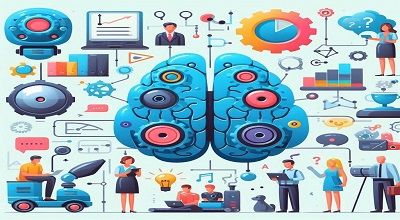Machine learning
Machine learning is a subset of artificial intelligence (AI) that focuses on the development of algorithms and statistical models. That enables computers to perform tasks without being explicitly programmed for those tasks. Here’s a breakdown of how machine learning operates:
- Data Collection: The first step in any machine learning process involves gathering relevant data. This data can come in various forms, such as text, images, and videos. Or numerical values, depending on the task at hand.
- Data Preprocessing: Once the data is collected, it often needs to be preprocessed to ensure its quality and prepare it for analysis. This step may involve tasks such as cleaning the data to remove errors. Inconsistencies, handling missing values, and transforming the data into a suitable format for the chosen machine learning algorithm.
- Feature Extraction/Selection: In many cases, not all the information in the data is relevant to the task at hand. Feature extraction or selection involves identifying the most important features (variables) in the data. That will be used to make predictions or classifications.
- Model Selection: Choosing the appropriate machine learning model for the task is crucial. There are various types of machine learning models, including supervised learning, unsupervised learning, and reinforcement learning. Each type of model is suited to different types of tasks and data.
More here…
- Training the Model: In supervised learning, the model is trained using labeled data. Where the input data is paired with the correct output. During training, the model adjusts its internal parameters to minimize the difference between its predictions and the actual output. In unsupervised learning, the model learns patterns and structures from unlabeled data. The training process involves exposing the model to the data multiple times (epochs) until it learns to make accurate predictions or identify patterns.
- Evaluation: After the model is trained, it needs to be evaluated to assess its performance. This is typically done using a separate dataset that the model hasn’t seen before (the test set). Evaluation metrics such as accuracy, precision, and recall. Or F1 scores are used to measure how well the model generalizes to new, unseen data.
- Hyperparameter Tuning: Many machine learning algorithms have hyperparameters that need to be set before training. Hyperparameter tuning involves selecting the best combination of hyperparameters to optimize the model’s performance.
- Deployment and Monitoring: Once a satisfactory model is trained, it can be deployed into production to make predictions on new data. It’s essential to continuously monitor the model’s performance in the real-world environment and retrain or update it as needed to maintain its accuracy and relevance.
Illustration
- Let’s consider a practical example: classifying emails as spam or not spam.
- Data Collection: Gather a large dataset of emails, each labeled as spam or not spam.
- Data Preprocessing: Clean the text data, remove any irrelevant information, and convert it into a format suitable for analysis.
- Feature Extraction/Selection: Extract relevant features from the email text, such as the presence of certain keywords or phrases.
- Model Selection: Choose a classification algorithm, such as logistic regression or a decision tree, suitable for the task.
- Training the Model: Train the chosen model using the labeled email data, adjusting its parameters to minimize classification errors.
- Evaluation: Evaluate the trained model’s performance using a separate test set of emails to measure its accuracy in classifying spam and non-spam emails.
- Hyperparameter Tuning: Fine-tune the model’s hyperparameters, such as the regularization strength or tree depth, to optimize its performance.
- Deployment and Monitoring: Deploy the trained model into an email system to automatically classify incoming emails as spam or not spam. Continuously monitor its performance and retrain it periodically to adapt to new spam patterns or changes in email content.
